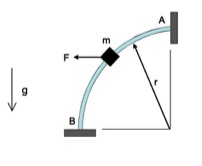| Problem statement Summary sheet for work/energy 1 Solution video |
DISCUSSION THREAD

Any questions?? Please ask/answer questions regarding this homework problem through the "Leave a Comment" link above.
| Problem statement Summary sheet for work/energy 1 Solution video |
DISCUSSION THREAD

Any questions?? Please ask/answer questions regarding this homework problem through the "Leave a Comment" link above.
Comments are closed.
For the integral from 1 -> 2 its F dot et which would give you Fcos(theta) inside the integral where theta is the angle between et and F. At point b the velocity is straight down and force is to the left so the angle is 90 so it would go to zero. That feels wrong as the answer asks for an answer that includes F as a variable. Is that a correct way to do the dot product or did I miss a step?
Dawson: Be very careful here. The work term is an INTEGRAL of the motion from position 1 to position 2. True, the integrand at position 2 is zero, but it is not zero over the entire range of motion. Therefore, you will find that the work done by F is not zero.
Physically, it would not make sense that the motion of B would not depend on the value of F.
Given that all forces in the problem are either constant (F and force from gravity) or perpendicular to motion (force from tangential acceleration/normal force) you can simplify this problem. By recognizing this you can utilize the fact that work is the vector of the constant forces dotted by the vector of the displacement. This work can then be used to solve for the final speed. Note that this is only valid because it is the constant forces that influence the collar's speed. This wouldn't be true if there was friction, if F was changing, or some other motion in the system.
F is in the -x direction. The particle moves a distance of r in the -x direction. If you split the integral into its x and y components, the limits of the x component would be 0-r, and the y component would go to 0 since the force does not act in that direction.
Does this problem still require a kinematics step? It seems like velocity can be found just through kinetics.
If that is the case, simply say in Step 3: "none needed."
Virtually all of the other problems that we will deal with in this course, kinematics is needed explicitly.
The way that I went about it I utilized kinematics. It is the equation that we are given of T1+V1+U(1-2)=T2+V2. Note that when finding the value for U(1-2), the integral does not evaluate to 0 like others were confused about as you are finding the range of motion for the block which results in an expression utilizing F. This is resolved through the use of the dot product in the integral.
In addition to everything else mentioned regarding the work integral, I found E.4.B.5 might be useful, since it is similar to this problem in setup (but it is reversed, with a similar force application).
This question is pretty straightforward. Make sure you draw an FBD and determine which forces are conservative and non-conservative, and set up your equation of T1+V1+U1-2 = T2+V2. Lastly, your applied force only acts in the x direction, and make sure you integrate it as such.
I found this thread useful for understanding why the work of the normal force is zero. It also explains conservative verus non-conservative forces. One interesting thing is that a force is conservative if its curl (gradient cross force) is equal to zero. https://physics.stackexchange.com/questions/49835/is-the-normal-force-a-conservative-force
I am doing the integral for Unc from 0 to -r and making -F. Since the force is being applied in the direction of motion, the work by the non-conservative forces should be positive right?
This depends on how you choose to view the positives and negatives. If you choose to keep your data with the direction of motion, and its related force, moving negative then yes the work of non-conservative forces will be positive to the right. It's just that NC forces will move opposite of the direction of motion, and are path-dependent.
Would, the location of the datum matter for this problem? Would it not matter because the values of your potential energies in your equation would be different with opposite signs?
The relationship between different variables would still remain the same regardless of which direction you chose to be positive or negative and where you chose to place your datum. If have V moving to the left and A to the right and need to isolate V and have V assigned as negative, you'd simply multiply the negative over, giving you the same answer as if you had flipped the datum signs. As long as your relationship is the same and correct I believe it should not matter.
Using Example 4.B.1, you can set up your kinetics eq. Since F is horizontal and mg is vertical, your integrals are simplified; ds = r.
Yes, the work of the non conservative forces should end up positive. Either you say F and the distance traveled of r are both in the -x direction, or because they are each traveling in the same direction, it is all positive. Either way, the work integral should end up positive.
This problem is a relatively straightforward application of the work-energy equation. An important thing to note is that U(nc) is not 0. The equation in the summary sheet, where U(nc) is simplified into its x and y components, can be used here.
I also found that this question is quite similar to example 4.b.5. However, need to make sure the work integration is set up properly.
Because the nonconservative force is only in the x direction. The path integral only has to account for the x movement along the path.